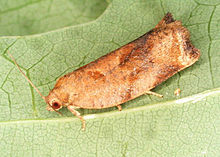Archips rosana
 From Wikipedia the free encyclopedia
From Wikipedia the free encyclopedia
| Archips rosana | |
|---|---|
 | |
| Scientific classification | |
| Domain: | Eukaryota |
| Kingdom: | Animalia |
| Phylum: | Arthropoda |
| Class: | Insecta |
| Order: | Lepidoptera |
| Family: | Tortricidae |
| Genus: | Archips |
| Species: | A. rosana |
| Binomial name | |
| Archips rosana | |
| Synonyms | |
| |
Archips rosana, the rose tortrix, is a moth of the family Tortricidae. It is found in both the Palearctic and Nearctic realms.

The wingspan is 15–24 mm. The forewings have a sinuate, vertical termen. sinuate. The costal fold from base to beyond middle, is irregular and light brown, sometimes reddish-tinged, in female darker-strigulated. There is a dorsal spot near the base. The anterior edge of the central fascia is sinuate. There is a suffused costal patch emitting an interrupted stria darker brown, in the female sometimes nearly obsolete and some dark terminal strigulae. The hindwings are grey, apex usually more or less orange. The larva is dark olive-green; dorsal line darker; tubercular spots white; head brown; plate of 2 blackish, anteriorly whitish.[2] Julius von Kennel provides a full description.[3]
The moths are on wing from May to August depending on the location.
The larvae feed within rolled leaves of various fruit plants such as raspberry, as well as cultivated rose. Pupation takes place from April to May. The species overwinters as an egg.[4]
References
[edit]- ^ tortricidae.com
- ^ Meyrick, E., 1895 A Handbook of British Lepidoptera MacMillan, London pdf
 This article incorporates text from this source, which is in the public domain. Keys and description
This article incorporates text from this source, which is in the public domain. Keys and description - ^ Julius von Kennel, 1921, The Palaearktischen Tortriciden, eine monographische Darstellung. Stuttgart: E. Schweizerbart'sche Verlagsbuchhandlung. 742 pp. - Palaearctic Tortricidae, a monograph.pdf at Zobodat 131 -132.
- ^ Bong-Kyu, Byun; Shan-Chun, Yan; Cheng-De, Li (2003). "Revision of Tribe Archipini (Tortricidae: Tortricinae) in Northeast China". Journal of Forestry Research. 14 (2): 93–102. doi:10.1007/BF02856773.
External links
[edit]